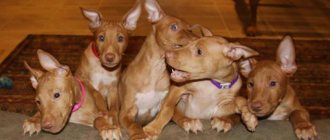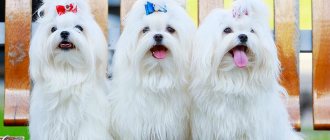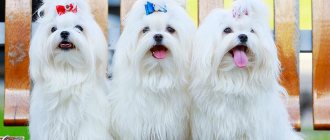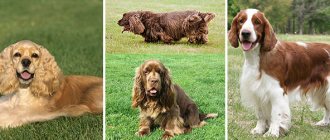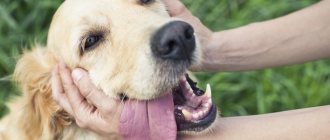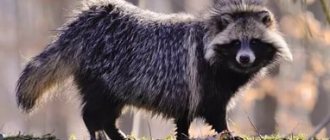The Pharaoh Hound is one of the most mysterious breeds. Despite the huge number of its admirers, there are no more than five thousand individuals all over the world that once belonged to the Egyptian kings.
In this article you will learn about the temperament of the Pharaoh Hound, its habits, diseases and some interesting facts about the breed that make it truly unique.
We will figure out how to choose the right puppy and how much it can cost, and in the end you will find out what owners think about their pets, the pros and cons of the breed and whether it is worth getting such a dog.
History of the origin of the breed
The first mentions are found in scrolls dating back to 4000 BC. In the images of antiquity, miraculously preserved to this day, we can discern the graceful silhouette of these animals. And the preserved colors give an idea that the pharaoh’s dog was fiery red with eyes reminiscent of the color of honey.
There was a legend - an entity from Sirius descended from the sky to people and lives nearby under the face of these animals. Therefore, only the pharaohs and the Egyptian nobility could afford such a dog.
Now there are more and more supporters of the version that the breed has nothing to do with ancient Egypt, but I would like to believe that the dogs have come down to us as a kind of living artifact.
In the 17th century, representatives of the breed came to Malta, where they were used for hunting rabbits. During this period, the breed became known as the “rabbit hunting dog.” After official recognition, which occurred in 1975, the image of the fiery dog of the pharaohs became a symbol of the island and was imprinted on collectible coins.
The appearance of representatives of the breed in European countries is associated with the 20th century. Here the pharaoh's hound was treated with due respect, and connoisseurs appeared.
Watch a short video where the famous journalist and dog handler Grigory Manev meets a biker Pharaoh Hound and tells why they sometimes howl at the sound of Maltese bells.
Saluki
The elegant and athletic Saluki is often considered one of the oldest dog breeds in the world. Their history goes back at least 5000 years . Dogs resembling modern Salukis were often depicted on ancient Egyptian tombstones and sculptures.
Thanks to its royal appearance and athletic prowess in the hunt, this greyhound was highly prized by the Egyptian pharaohs and other prominent leaders such as Alexander the Great. The Saluki was probably first bred in the Fertile Crescent region, but its popularity grew over the years and the Saluki became common in the Middle East, Egypt and Asia.
The Greyhound is the fastest dog over short distances, but the Saluki will easily outperform it over longer distances. They can reach speeds of up to 69 km per hour and maintain it for a relatively long time. They have fairly soft feet that absorb shock waves while running, giving them more endurance.
The typical prey of these animals were hares, foxes, gazelles and jackals. Salukis were sometimes transported on camels, and when prey appeared, the dogs would jump from the saddle, giving them an instant advantage in speed. Salukis still behave like hunting dogs today. They are reserved towards strangers, but are by no means aggressive. True, this is not the best choice for living in a house full of small furry pets.
IMPORTANT! Salukis can be independent and even stubborn, making them difficult to train. Only patience and the use of gentle positive reinforcement can produce excellent results.
Salukis form strong bonds with their family and should not be left alone for long periods of time. Separation may cause them anxiety. These dogs are renowned for being obedient and calm when given enough exercise. Salukis do not like rough play, but they will not refuse soft toys.
Description of the breed
Over the long centuries of its existence, the breed has not been crossed with others and is considered primitive. When its first representatives arrived in the UK, dog handlers were quite surprised - it did not need additional selective work.
Therefore, we can say with confidence that what appears before our eyes are exactly those fiery red dogs that accompanied the majestic kings of Egypt in their luxurious palaces many centuries ago.
Photo: wikimedia.org
Colors
From the name it is clear that the fiery dog is a very brightly colored dog, in shades from brown to red.
According to the standard, the presence of white spots on the chest, crown, tip of the tail, on the forehead or on the bridge of the nose is acceptable. Such white spots will not interfere with the breed, while spots on the body of the animal are a disqualifying feature.
On the Internet you can see photographs of pharaoh dogs in gray or black or blue colors. If you see an image of such animals, this will mean that this is a breed that is similar to the pharaonic one.
Albinos are also found among the breed : completely white or white with red markings. This is rare and is a defect according to the standard, but such puppies are especially popular and in demand because of their unusual nature.
Standard
The recognition of the breed did not proceed entirely smoothly, since by 1977 there was already an officially registered breed of Pharaoh Dogs, whose homeland was Ibiza. It is not possible to register two breeds with the same name with the FCI.
Dog handlers from the organization went to meet the ancient breed and registered it, and renamed the dogs from Ibiza - Ibizan Greyhound.
An interesting situation arose - it was England that became the patron of the breed, although Malta was officially recognized as its homeland, and the bulk of its representatives are concentrated in American nurseries.
The first representative of the breed appeared in the USSR in 1987, now it is registered in the RKF and belongs to the greyhounds.
Photo: wikimedia.org
Breed standard:
- adult height: males from 56 to 62 cm (56 cm is considered ideal), females - from 53 to 61 cm;
- weight should vary between 18 – 26 kg;
- the head is wedge-shaped and is located on a long neck;
- the ears are large in size relative to the head, certainly erect;
- the eyes are small, round in shape and have a unique color that can be described as honey or amber;
- the body is elongated, with shoulders laid back and long slender limbs;
- paws with pronounced muscles and hard pads;
- the coat is short, the hairs are very hard, without undercoat;
- the bite has the correct shape, without the formation of a gap;
- the tail is long, straight, tapering towards the end;
- dogs are considered long-lived, their life expectancy is, on average, a record 14 years.
The dog of the Egyptian kings has a unique feature for animals - it can “blush.” During moments of excitement, the dog’s earlobes and nose turn red.
Watch a short video from the All-Russian Dog Show.
Similar breeds
There are several breeds in the world that closely resemble pharaoh dogs in their appearance. We can highlight:
- Xoloitzcuintle. The dog's body has similar outlines, but the color of such a dog is almost black. A distinctive feature is the presence of an “Iroquois” and a strong difference in size - the Mexican dog is a mini copy of the pharaoh;
- Podenco Ibicenco. They differ in color, build and tail shape;
- Cirneco del Etna. The most similar breed, but small - almost 10 cm lower at the withers than the Pharaoh's dog.
Ibizan Greyhound
The Ibicenco Podenco is considered a native of the Balearic Islands, located off the Spanish coast. However, these native hunting dogs are another breed that can easily trace their ancestry back to Ancient Egypt. Drawings of dogs strikingly similar to this breed have been found on various tombstones and historical artifacts.
They have become an integral part of island life. These dexterous and determined hunters have adapted to quickly overcome rough terrain and catch rabbits for their masters.
Due to their energy and stamina, Ibizan Greyhounds are best suited to active owners who can offer them an outlet for their energy. With sufficient exercise, Ibizan Greyhounds will make docile, affectionate and relatively quiet pets.
This sensitive breed is easily stressed, so balanced owners are recommended for Ibizan Greyhounds; they will not tolerate rude treatment. And, of course, ideally, it is better for them to live in a house without small fur-bearing animals, since they have retained their innate hunting instincts.
Character and behavioral characteristics
Owners who have such pets note their amazing friendliness. Another amazing ability of dogs is their ability to smile. From an overabundance of feelings, the Pharaoh Hound bares its teeth, but this is not aggression, but a manifestation of emotions.
The dog’s ability to empathize with the owner is also interesting: he will rejoice and jump around, but he will also fall into a depressive state and refuse food in case of serious troubles.
The Pharaoh Hound needs constant contact with humans. For all her independence, she knows how to please, looking soulfully into her eyes and expecting praise.
Gets along well with small family members, becoming a partner in noisy games. It does not pose a danger to a child, but given the size of the dog, during such games it can destroy half the apartment.
Look how the Pharaoh Hound behaves with the baby!
Capable of living together with other animals. If you don't train them, it will be difficult to suppress the hunter's instinct, and small family pets may be in danger. However, with proper upbringing, you can grow up to have best friends, for example, like Hatti and Busya.
To tame the source of energy surging inside the fire dogs, long walks with active games are necessary.
Psychology
A dog's cheerful disposition can be manifested not only by excessive energy and playfulness.
In a fit of joy, the animal can even “smile,” characteristically wrinkling its nose and stretching its mouth.
At these moments, all the goodwill and openness of the breed is revealed.
Other character traits:
- Devotion. The animal quickly becomes attached not only to the owner, but also to all family members, shows care and affection, at the same time, like the Beauceron and Kangal , it is quite wary of strangers, but does not show aggression without reason.
- Pronounced hunting instinct. Having smelled prey, the dog rushes to hunt, without listening to any commands from the owner, and shows aggression towards rodents like degu squirrels and lemmings , birds and even cats.
- High intelligence. Pharaoh dogs are very smart and independent, capable of making independent decisions. If the animal considers the owner’s order to be incorrect, it will not carry it out.
You can read about other smart dog breeds in the article
The feeling of shame makes the dog blush in the literal sense of the word - the rims of the eyes, ears, and nose begin to turn red in a conscientious dog
- Fast learner. train positively and do not accept physical punishment or coercion. They quickly get tired of repeated commands, so training should be dynamic and interesting.
- Activity and playfulness. Pharaoh dogs, like hounds , are very active and playful, have a huge supply of energy, so they need daily exercise.
- Conscientiousness. The feeling of shame makes the animal blush in the literal sense of the word - the rims of the eyes, ears, and nose begin to turn red in a conscientious dog.
- Love for children. The animal is great with children, just like a Boerboel or Dogue de Bordeaux .
This article will tell you about other dog breeds that are great for children.
Pharaoh Hound loves the good life
Education and training
Socialization and house training should begin as early as possible. Babies can be very timid and the owner needs to show them the world around them.
During training, non-standard methods are used, constantly changing the approach to avoid boredom. It is important to take a leadership position that the dog will constantly question.
You should pay special attention to the waywardness of the animal and additionally work on its hunting behavior. The animal often ignores commands and can eat the object of the hunt.
Watch how Cleopatra hunts for a skin in training.
An unpleasant feature of pharaoh dogs is that they eat feces. This is common to many animals, but this particular breed eats them for safety reasons.
Armant
This is a rare breed with an unusual backstory. Today armants are found mainly in Egypt. However, most likely, they were originally European dogs that somehow ended up on the African continent, where they formed their own breed. Some experts believe that the Harmant was brought to Egypt by Napoleon's army and was probably crossed with local breeds.
Armants are named after the Egyptian city of the same name, which is apparently where the breed was first developed. This is a fairly rare breed, especially outside of Egypt. At home, they are used as herding and guard dogs. They are rumored to have been used as herding dogs in Napoleon's army, which explains how they have strong herding instincts!
Diseases
Despite good health, a number of issues and diseases can be identified:
- Due to the small amount of adipose tissue, it is difficult to tolerate anesthesia. A lower dose is required than in other animals of the same weight;
- tendency to allergies. The owner should be very careful and not self-medicate, since the dog may have a severe allergic reaction to any drug;
- prone to ear infections;
- Joint dislocations and dysplasia are common.
Photo: wikimedia.org
Timely vaccinations and timely contact with a specialist play a huge role in the condition of the Pharaoh Hound.
Application
Pharaoh dogs, like the Karelian-Finnish and West Siberian huskies , are a hunting breed with a pronounced anger towards the beast.
A strong hunting instinct makes them forget about everything in the world if they see potential prey nearby.
Be careful not to remove your pet's harness if there may be any animals nearby.
Hey captain! Full speed ahead!
Estrus
The owner needs to know:
- the first heat can begin at the age of 6, 12 months or one year;
- duration on average is 22 days, can be longer (up to a month); frequency – 1 or 2 times a year;
- the main signs of the onset of estrus are swelling of the external genital organs and the presence of bloody discharge;
- During this period, bitches experience increased urination, frequent walks will be necessary;
- during the period of heat, walking is done strictly on a leash;
- To protect household items from contamination, you can use special underpants for dogs.
Nicknames
The nicknames for these dogs often play off their “ancient Egyptian” origin. Other mythological names are also suitable:
| For boys | For girls |
| Ramses | Cleopatra |
| Tutankhamun | Nefertiti |
| Pharaoh | Nefertari |
| Osiris | Isis |
| Anubis | Maat |
| Ra | Astarte |
| Gore | Devi |
| Set | Ishtar |
| Helios | Mayan |
| Boreas | Etna |
Pregnancy
Pregnancy in dogs lasts from 56 to 72 days. The owner must know exactly the date when the mating took place in order to be prepared for the birth. It is worth remembering that early or late birth will most likely lead to the death of puppies, so you should seek help from a veterinarian.
In the later stages, pregnancy can be determined by a veterinarian or the owner himself, since the bitch’s mammary glands and abdomen will enlarge, and yellow discharge will begin from the loop.
Photo: wikimedia.org
Care
Red fiery beasts are very clean and do not require special care. The owner should follow a number of rules, and his Pharaoh Hound will always be in excellent condition:
- The animal sheds all year round, so combing is carried out with a special mitten or go to the salon for a grooming procedure;
- the fur does not smell like a dog, so bathing is carried out twice a year, using hypoallergenic shampoo;
- regularly trim nails and treat ears;
- regularly getting rid of parasites, choosing a remedy empirically to avoid allergies.
For a healthy dog, the main care is regular walks with physical activity.
Choice of clothes
The breed is not adapted to life in low temperatures, so to protect the pet it is necessary to purchase clothing for it. The stores offer a wide range, but the choice should be made based not on the beauty of the suit, but on its functionality and correct size.
Health problems and vaccinations
Pharaoh dogs are long-lived. On average, they will stay in your family from 15 to 18 years. It is especially important that representatives of this breed do not lose mental abilities and athleticism even in old age.
A strong breed gene pool has two sides to the coin. The positive aspect is that dogs have very few possible health problems. However, hereditary diseases are passed on to descendants with a high probability.
In general, Pharaoh Hounds can suffer from ailments such as:
- Volvulus of the intestines or stomach. This disease most often occurs due to weakening of the muscles that support the organs of the digestive tract. A clear sign is swelling of the peritoneum. You can only save your pet through surgery.
- Dysplasia of the hip and elbow joints. This disease is an age-related disease that provokes acute pain under heavy loads. Over the years, this disease progresses as the animal’s metabolic rate decreases and, as a result, the regeneration of articular tissues slows down.
- Congenital dislocations of the knee joints. With this disease, the puppy is born with already damaged limbs (the reason for which is defective development of ligaments). This cannot always be determined visually, but a dog with pathology is prone to re-injury.
- Allergies. Pharaoh Hounds are very sensitive to chemicals and do not respond well to anti-parasitic collars or anti-flea treatments. Shampoos and other natural-based products are used for them.
To prevent the animal from contracting infections, it is necessary to vaccinate. Usually, “pharaohs” tolerate this procedure without complications. The dog is vaccinated for the first time at 1.5 months, and after 14 days, revaccination is carried out. The next injections are administered at 6–7 months, then every year throughout the animal’s life. Pets are vaccinated against leptospirosis, parvovirus enteritis, distemper, parainfluenza, rabies, and Lyme disease.
It is important to understand that the dog must be absolutely healthy to be vaccinated. Therefore, 10 days before the procedure, the pet needs to be given an anthelmintic drug, for example, Milbemax.
Important! It takes some time for immunity to develop. For the first 7–10 days after vaccination, you should not walk with your pet in places where there are a large number of other animals.
Feeding
Due to the propensity of the pharaohs to obesity, the diet is designed in such a way that it is extremely balanced. When using dry food, choose exclusively premium class food.
The basis of natural nutrition should be:
- meat;
- cottage cheese;
- cereals;
- vegetables.
Some owners even organize a week of Japanese cuisine for their pets, check it out!
If you notice that your pet has gained weight and his sides are “sticking out,” you should not starve him. Contact your veterinarian to prescribe a diet or simply reduce the portion.
Price and where to buy a puppy
When looking for a baby of such a rare breed, you can only contact a well-known nursery. It is impossible to purchase a representative of this breed on the poultry market. When choosing a baby, pay attention to the reputation of the breeder and the living conditions of the puppy’s parents.
The cost of puppies depends on exhibition prospects. And if a baby with defects and without documents can be sold to you for $1,000, then an elite individual will cost five times more.
Photo: wikimedia.org
What do you need to know when choosing a Pharaoh Hound puppy?
It is advisable to choose a puppy from a breeding kennel with a good reputation
This question is very relevant. Pharaoh Hound puppies are expensive, prices from different breeders are almost the same, but the quality, unfortunately, is not. When purchasing a dog, you want to have a beautiful, standard, healthy animal with a good nervous system. So how do you make the right choice?
You can pick up a “Pharaoh” puppy at 1.5–2 months, but it is important to pay attention to the following aspects:
- He must be well-fed, active when awake, and also have a good appetite.
- A healthy puppy has strong bones and straight limbs. Thickening in the joint area is acceptable - these are the so-called “growth zones”.
- Examine the baby's appearance. The coat should be smooth, dense and shiny. The tail is straight and long, without kinks or curvatures.
Thin skin through which the ribs protrude, tousled dry hair, protruding maklaks, scabs are signs that indicate that it is better to refuse to purchase such an animal.
Inspect the place where the baby was born and lives. It should be kept in a clean, dry and well-ventilated area, without strong odors. In the puppy's behavior, evaluate how the animal reacts to the appearance of a new person. A healthy baby is friendly, not aggressive, does not press to the ground when raising his hand, and responds adequately to stroking.
Pharaoh Hound puppies are born with blue eyes. A yellowish tint appears after 2.5–3 months, which gradually turns into amber. Therefore, you should not be afraid that you are being offered a mongrel dog; this phenomenon is within normal limits. It is also quite natural that the ears of the little “pharaoh” have a hanging position. They stand up at about 3–4 months.
Important! Sometimes a dog's ears become erect by the age of 1 month. However, dog handlers know that this phenomenon is typical for puppies with excessively light bones. Such pets, as a rule, grow up a little narrow and poor-boned.
Always pay attention to the puppy's mother. If they show you an exhausted and tired bitch, and the breeder explains that she was “sucked” by the babies, this, alas, is deceit. Under normal conditions, a dog is fed quite well during pregnancy and lactation, so it gains weight rather than loses it. You should not risk buying a baby from a sick animal.
A conscientious breeder will also always provide a full package of documents for the pet: pedigrees of the parents, grades, exhibition titles and certificates, vaccination card. You shouldn’t refuse to study them and say that you don’t understand it. It is the responsibility of the breeder to explain every question that interests you. The seller is also required to provide documents for the puppy: a veterinary passport, which indicates age-appropriate deworming and vaccinations, a puppy card and recommendations for caring for the baby.
Owner reviews
Maria : don’t be afraid to train the dog yourself. It's very simple. He makes contact well, you just need to do it in the form of a game. It is advisable not to leave him alone for a long time - he will dismantle half the house. From the first days, take care of your health and problems will not arise. It’s still interesting how puppies’ eyes change from turquoise to amber. By the way, people pay a lot of attention to dogs on the street :)
Vladislav : It’s very difficult to say something definite. We love our dog very much, we got it after we played with him enough. We overcame everything: they taught us commands, weaned us from hooliganism. But he is often sick and constantly catches colds. It’s good that you have now found “your” veterinarian, he understands the breed and dosage of medications. One thing I can say for sure – children are best friends!
Dmitry : I advise you to keep the pharaoh in a private house. In the apartment he will bark and howl from loneliness. But even in the house he keeps an eye on him. He will jump over the fence and get his prey. So catch him in the neighbors. In general, like any dog, he requires attention and patience, but he will answer you with absolute love and devotion.
Baladi
Technically, this dog is not a breed at all. However, the Baladi is one of the most common dogs in Egypt. They are known as Egyptian street dogs , so they are not bred by breeders, but are randomly bred together as stray dogs. Many of these dogs are similar in appearance to each other, as most of them have been living on the streets for several generations.
Baladi are light-skinned and thin, with long legs and huge erect ears. Most of them have curled tails. These animals love people and quickly adapt to life in the home. They are well mannered and can easily learn commands .
Another feature of them is that they speak in a growling voice instead of barking. This can be a little off-putting at first, as many people think the dog is being aggressive. In fact, this is a very calm dog.
Advantages and disadvantages
To make it easier for our readers to decide on their desire to purchase a pet of this breed, we will highlight the positive and negative qualities of the Pharaoh Hound.
pros
- loyalty;
- intelligence;
- excellent hunter;
- gets along with children;
- does not require special care.
Minuses
- stubbornness;
- tendency to allergies and poor tolerance to anesthetics;
- puppy cost;
- tendency to hypothermia.
How to choose a puppy
Pedigree breeding is a rather complex process, so Pharaoh dogs have a narrow gene pool, which complicates the process of choosing a purebred representative.
A purebred Pharaoh Hound puppy has a flexible body with a straight top line and formed lower legs, the dog's paws are strong with dense pads.
The stomach is tucked, the chest is deep, the neck is slender and muscular, slightly arched.
The puppy's nose is flesh-colored, his eyes are amber and deep-set.
Any deviation from the standard is considered a defect.
Pharaoh hound puppies are very affectionate and playful. They easily get along with children
Photo
Photo: wikimedia.org
Photo: wikimedia.org
Photo: wikimedia.org

